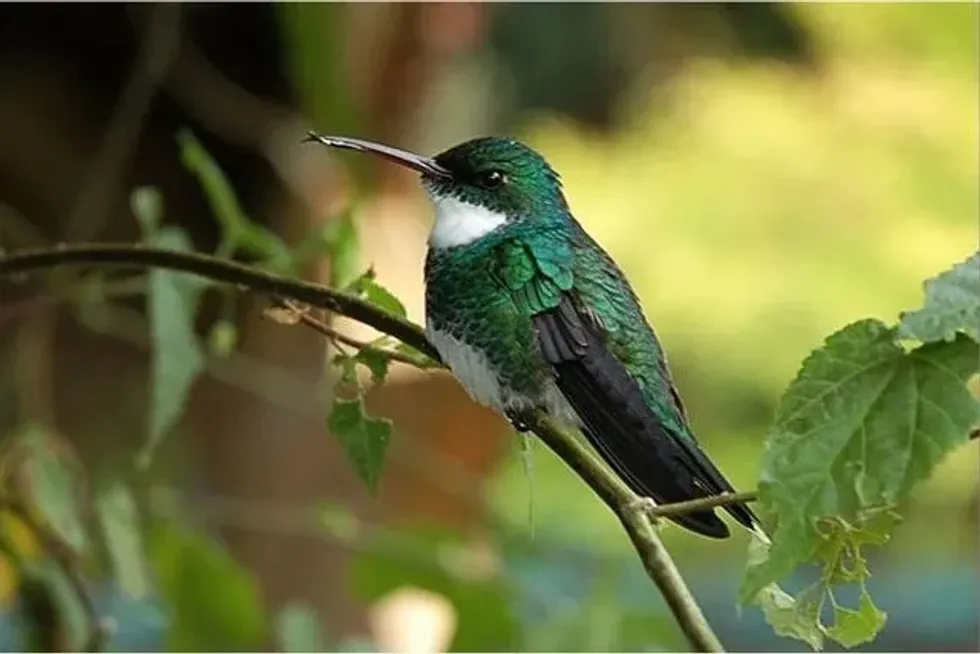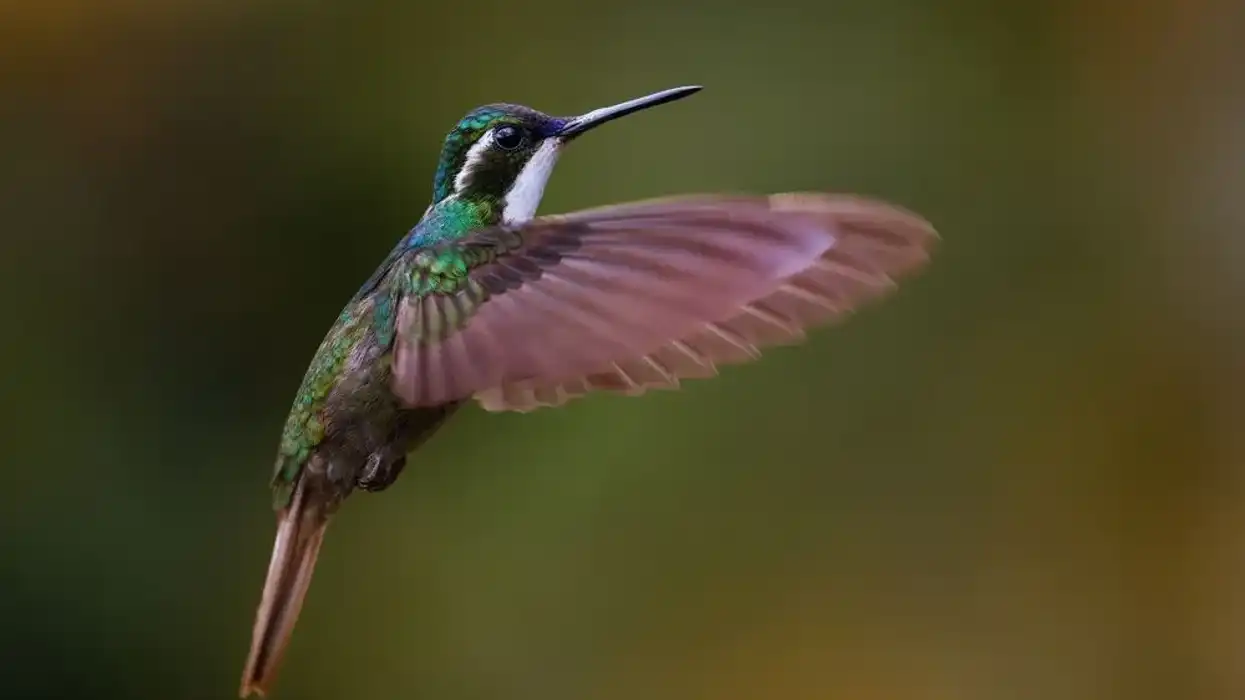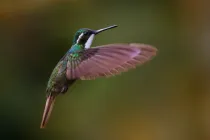Fun White-throated Hummingbird Facts For Kids

The white-throated hummingbird (Leucochloris albicollis) is one of the several species of hummingbirds that are thought to have originated from the lineage of the genus Amazilia. Species like the rufous-throated sapphire (Amazilia sapphirina), green-and-white hummingbird (Amazilia viridicauda), gilded sapphire (Hylocharis chrysura), and sapphire-spangled emerald (Amazilia lactea) are believed to have developed from this genera.
A fascinating fact about male hummers is that they possess iridescent feathers around their throats. While the females find the throat region of the males extremely attractive, the other males are deterred.
All male hummingbirds have two major objectives.
The first is to appease the females, whereas the other target is to protect their territory (which falls within the breeding range along with plentiful food). The red color in the throats of the males is a symbol of their territorial display.
Hummingbirds are migratory, and during the winter months, these tiny little birds can cover long distances. They can even fly across the Gulf of Mexico!
For migrating to places that are at a considerable distance, the hummingbirds indulge in loaded meals where they store fat that is eventually used up during the flight interval.
For instance, rufous hummingbirds are the hardiest among all hummingbirds as they can cover a huge distance of 3,000 miles. They engage in a direct flight right from the nesting grounds situated in Canada (Quebec and other provinces) and Alaska straight to their wintering grounds in Mexico.
Continue reading to be more aware of some intriguing facts about the white-throated hummingbird, and if you are enthusiastic about exploring more awe-inspiring facts about other unique species of birds, then don't miss out on umbrellabird facts and blue jay facts.
White-throated Hummingbird Interesting Facts
What type of animal is a white-throated hummingbird?
A white-throated hummingbird is a species of bird belonging to the Trochilidae family.
What class of animal does a white-throated hummingbird belong to?
The white-throated hummingbird has been categorized under the class Aves.
How many white-throated hummingbirds are there in the world?
The number of white-throated hummingbirds in existence cannot be mentioned due to a lack of quantification. However, they are widespread across several countries in the world and studied in places like the United States of America.
Where does a white-throated hummingbird live?
The white-throated hummingbird is common around places like Paraguay, southeastern Brazil, northeastern Argentina, and Uruguay. They are not found in North American countries like the United States of America.
Like all other hummingbirds, they are migratory, and they fly off to the other North American country of Mexico during the harsh winter months. The ruby-throated hummingbird and the rufous hummingbird are also known to engage in lengthy flights and occupy the United States (Wisconsin, Texas) and Canada (Quebec).
What is a white-throated hummingbird's habitat?
These birds have a wide-ranging habitat that includes forests, wetlands, woodlands, shrublands, gardens, and parks. They can also be located in marshy regions.
Who do white-throated hummingbirds live with?
Contrary to most other bird species, hummingbirds do not stick in flocks. They like to be solitary dwellers, and even while migrating, they engage in long solo flights.
How long does a white-throated hummingbird live?
Although the accurate life span of the white-throated hummingbirds cannot be mentioned due to the scarcity of records, it is worth mentioning that, in general, the hummingbirds live up to a maximum age limit of about eight years.
How do they reproduce?
The behavior of the white-throated hummingbird during reproduction is unknown. Nevertheless, it can be deduced that the breeding procedure is similar to that of other hummingbirds.
Normally an adult male hummingbird tries to entice the female by showing off its bright feathers and flying skills. Breeding grounds are located near food sources with plenty of nectar-producing flowers or hummingbird feeders.
Once the adult male finds a suitable mating partner, it dives straight at the female. This behavior ultimately ends up in copulation. After breeding, the female bird is left alone to construct its nest and bring up the hatchlings.
A female will build the nest out of lichens, mosses, and other available objects from the surroundings and secures the nesting materials by binding them with spider-web. The female mother defends the nest and raises the clutch singlehandedly.
The clutch size of the hummingbirds consists of just two eggs. Hummingbird nests are difficult to trace.
What is their conservation status?
The species has been categorized and marked as Least Concern by the International Union for Conservation of Nature (IUCN) Red List. Although their numbers have not been recorded, their ample distribution makes these hummers invulnerable.
White-throated Hummingbird Fun Facts
What do white-throated hummingbirds look like?

These multi-colored birds possess the tiniest size among all species of birds. The white-throated hummingbird identification is characterized by its distinct white throat patch (gorget) as well as the white tip of its tail, white-colored belly, and breast region.
The primary body color is iridescent green, while its wing feathers are in the bright shades of purple-brown. They also have a sharp, elongated bill. The iridescent color of their feathers and tail feathers gives them a vibrant metallic sheen caused due to the refraction of light.
How cute are they?
For all bird watchers, the hummingbirds are a treat to the eyes. Their small size, tail feathers, and beautiful gorget make them difficult to trace, but the glamorous bright colors make their appearance lustrous and beautiful.
How do they communicate?
This hummingbird with the white gorget communicates through vocalizations and body language. Vocalizations include chirping and chittering.
Sounds like 'kwee-chik-chik' and 'chi-chi-chi' have been recorded. They also make loud buzzing sounds with their tail feathers and engage in aerial displays. The hummingbirds are extremely aggressive when it comes to protecting their marked territory, often located near food sources.
The males enter into showdowns with other males, butterflies, and bees who challenge them by encroaching upon their feeding area, flowers in the area, or hummingbird feeders. On rare occasions, the fight turns out to be fatal.
How big is a white-throated hummingbird?
The white-throated hummingbird is minute in size reaching a length of about 4-4.5 in (10-11.5 cm) only. The species is larger than the calliope hummingbird but are three times smaller than blue jays found in Texas.
How fast can a white-throated hummingbird fly?
Although no specific data is available about the flight speed of the white-throated hummingbird, it is safe to say that their speed limit does not exceed 30 mph (48 kph), which is considered to be the fastest achievable forward speed of the hummingbirds. The species has an upper elevation limit of up to 3,280 ft. (1,000 m).
How much does a white-throated hummingbird?
The white-throated hummingbirds have a body weight that ranges from about 0.16-0.28 oz (4.5-8 g). While the bodyweight of the males spans around 0.17–0.28 oz (5-8 g), the adult females weigh approximately 0.16 oz (4.5 g).
What are the male and female names of the species?
Similar to the other species of birds, the males are called 'cocks' while the females are called 'hens'.
What would you call a baby white-throated hummingbird?
A baby hummingbird is referred to as a nestling, chick, or hatchling.
What do they eat?
These birds are omnivorous. The favorite food of these white-gorget birds is nectar from flowers. However, the hummingbirds are very agile with high metabolism, due to which they are known to be voracious in their diet.
Other than nectar, their diet comprises small insects from where the requirements for high amounts of fat and protein are quenched. Did you know that hummingbirds feed three to four times a day? Their everyday meal has proportionate amounts of nectar as well as insects.
Are they poisonous?
White-throated hummingbirds of the Trochilidae family are not at all toxic. They are not known to be harmful in any way to human beings.
Would they make a good pet?
The white-throated hummingbirds can prove to be charming pets as they are known to share a good rapport with human beings. They remember human faces and often return to the nectar feeders.
However, the bird of the wild must not be removed from their natural habitat and enclosed in cages just for some companionship. Keeping these birds as pets is a criminal offense.
Did you know...
If you consider the hummingbirds as good singers, then you're entirely wrong! They do not croon melodious notes. In fact, they are always steering clear of loud music or sounds that scare them.
The scientific name of white-throated hummingbird, Leucochloris albicollis, has its roots in the Latin language, where the word albus means white, whereas collum implies neck.
The small fluttery wings give the hummingbird its speed. They can beat their wings in ultra-swift mode with an average of 10 to 15 beats per second.
The fastest wingbeats have been recorded at 80 beats per second (the amethyst wood-star hummingbird). The species has derived its name from the brisk movement of its wings. The movement of wings is so fast that they generate a humming sound.
Hummingbirds are violent territorial birds. Both the males and females engage in aggression. Given that the species possesses a very small body, you might wonder how. They mostly use sounds for this purpose and indulge in a lot of bickering to ward off other male intruders.
Hummingbirds have the ability to rotate and twist their wings backward. Unlike other species, they can fly backward, upside-down, or even hover above flowers for nectar.
Some other interesting hummingbirds to look up include the bee hummingbird and the lucifer hummingbird.
How long does a hummingbird sleep?
If you ever come across a hummingbird upside-down with a very cold body hanging from a perch in your garden, then don't mistake it to be dead. Hummingbirds have unique sleeping habits. Their special way of napping is called torpor.
During sleep, they become highly inactive with a very low heart rate (of about 50 beats every minute), almost hypothermic body temperature, and very slow breathing. Females in charge of hatchlings doze off in their nest.
During this time, they are in energy-saving mode. The torpor period lasts for about 20 minutes to almost an hour. Once they overcome their stupor, the birds immediately engage in foraging.
How can you tell a male from a female hummingbird?
Generally, the male and female hummingbirds can be differentiated on the basis of the varying color of their body and throat feathers. The males possess more radiant feathers when compared with the females.
The identification of a male depends on its green, orange, or rufous-colored body feathers. The male has a significant red throat while its back and belly come in the shades of iridescent orange. On the other hand, a female exhibits a throat with little spots of orange along with a green back.
Here at Kidadl, we have carefully created lots of interesting family-friendly animal facts for everyone to discover! For more relatable content, check out these little bee-eater facts and sooty grouse facts for kids.
You can even occupy yourself at home by coloring in one of our free printable white throated hummingbird coloring pages.
We Want Your Photos!
More for You
See All
Bachelor of Arts specializing in Journalism and Mass Communication, Postgraduate Diploma in Sports Management

Moumita DuttaBachelor of Arts specializing in Journalism and Mass Communication, Postgraduate Diploma in Sports Management
A content writer and editor with a passion for sports, Moumita has honed her skills in producing compelling match reports and stories about sporting heroes. She holds a degree in Journalism and Mass Communication from the Indian Institute of Social Welfare and Business Management, Calcutta University, alongside a postgraduate diploma in Sports Management.
Bachelor of Arts specializing in Economics

Gowri RaoBachelor of Arts specializing in Economics
With a bachelor's degree in Economics from Krea University, Gowri is a highly skilled data analyst and an expert in regression and causation modeling. Her interests in economic trends, finance, and investment research complement her professional expertise. In addition to her professional pursuits, Gowri enjoys swimming, running, and playing the drums, and she is also a talented tutor.
Disclaimer
1) Kidadl is independent and to make our service free to you the reader we are supported by advertising. We hope you love our recommendations for products and services! What we suggest is selected independently by the Kidadl team. If you purchase using the Buy Now button we may earn a small commission. This does not influence our choices. Prices are correct and items are available at the time the article was published but we cannot guarantee that on the time of reading. Please note that Kidadl is a participant in the Amazon Services LLC Associates Program, an affiliate advertising program designed to provide a means for sites to earn advertising fees by advertising and linking to Amazon. We also link to other websites, but are not responsible for their content.
2) At Kidadl, we strive to recommend the very best activities and events. We will always aim to give you accurate information at the date of publication - however, information does change, so it’s important you do your own research, double-check and make the decision that is right for your family. We recognise that not all activities and ideas are appropriate for all children and families or in all circumstances. Our recommended activities are based on age but these are a guide. We recommend that these ideas are used as inspiration, that ideas are undertaken with appropriate adult supervision, and that each adult uses their own discretion and knowledge of their children to consider the safety and suitability. Kidadl cannot accept liability for the execution of these ideas, and parental supervision is advised at all times, as safety is paramount. Anyone using the information provided by Kidadl does so at their own risk and we can not accept liability if things go wrong.
3) Because we are an educational resource, we have quotes and facts about a range of historical and modern figures. We do not endorse the actions of or rhetoric of all the people included in these collections, but we think they are important for growing minds to learn about under the guidance of parents or guardians.







